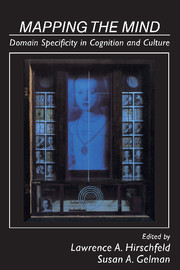Book contents
- Frontmatter
- Contents
- List of contributors
- Preface
- Part I Overview
- Part II The origins of domain knowledge: Biology and evolution
- 2 The modularity of thought and the epidemiology of representations
- 3 The organization of lexical knowledge in the brain: Evidence from category- and modality-specific deficits
- 4 Origins of domain specificity: The evolution of functional organization
- Part III The origins of domain knowledge: Conceptual approaches
- Part IV Are domains theories?
- Part V Domains across cultures and languages
- Part VI Implications for education
- Author index
- Subject index
2 - The modularity of thought and the epidemiology of representations
Published online by Cambridge University Press: 04 August 2010
- Frontmatter
- Contents
- List of contributors
- Preface
- Part I Overview
- Part II The origins of domain knowledge: Biology and evolution
- 2 The modularity of thought and the epidemiology of representations
- 3 The organization of lexical knowledge in the brain: Evidence from category- and modality-specific deficits
- 4 Origins of domain specificity: The evolution of functional organization
- Part III The origins of domain knowledge: Conceptual approaches
- Part IV Are domains theories?
- Part V Domains across cultures and languages
- Part VI Implications for education
- Author index
- Subject index
Summary
Ten years ago, Jerry Fodor published The Modularity of Mind, a book that received much well-deserved attention. His target was the then-dominant view according to which there are no important discontinuities between perceptual processes and conceptual processes. Information flows freely, “up” and “down,” between these two kinds of processes, and beliefs inform perception as much as they are informed by it. Against this view, Fodor argued that perceptual processes (and also linguistic decoding) are carried out by specialized, rather rigid mechanisms. These “modules” each have their own proprietary data base, and do not draw on information produced by conceptual processes.
Although this was probably not intended and has not been much noticed, “modularity of mind” was a paradoxical title, for, according to Fodor, modularity is to be found only at the periphery of the mind, in its input systems. In its center and bulk, Fodor's mind is decidedly nonmodular. Conceptual processes – that is, thought proper – are presented as a big holistic lump lacking joints at which to carve. Controversies have focused on the thesis that perceptual and linguistic decoding processes are modular, much more than on the alleged nonmodularity of thought.
In this chapter, I have two aims. The first is to defend the view that thought processes might be modular too (what Fodor [1987: 27] calls “modularity theory gone mad” – oh well!). Let me however echo Fodor and say that, “when I speak of a cognitive system as modular, I shall… always mean ‘to some interesting extent’” (Fodor, 1983: 37).
- Type
- Chapter
- Information
- Mapping the MindDomain Specificity in Cognition and Culture, pp. 39 - 67Publisher: Cambridge University PressPrint publication year: 1994
- 210
- Cited by



